|
Victoria, B.C.
The best of The British Museum's Egyptian collection has energized
the entire city of Victoria. Eternal Egypt: Masterworks of Ancient
Art runs until October 31 at the Royal B.C. Museum and the lines to
visit are long and enthusiastic. This tour will be the first and most
likely the last time these treasures will be seen in North America.
Following its next and final stop in Montreal, the 144 pieces will
return to a permanent and newly renovated venue at The British Museum.
Instead of moth-balling the artifacts during the renovation, the Museum
sent them on a North American tour which started in Toronto 10 cities
ago. This exhibit brings the Royal BC Museum into the realm of the
major world's museums like the Field and the Met. There is not a minor
piece in the whole collection, which is insured for $600 million.
The artifacts span 3,000 years from the great pyramids to the era
of Cleopatra. Arranged chronologically, the exhibit guides you along
the evolving cultural, social and artistic history of ancient Egypt.
In addition to the actual exhibit, the museum's IMAX Theatre has also
arranged to show the 40-minute award-winning movie "Mysteries
of Egypt," five or more times a day. This beautiful production
starring Omar Sharif and Kate Maberly gives an entertaining and broad
historical background for a better understanding of the exhibit. (Joint
tickets for both the exhibit and the movie may be reserved at the
same time.)
Just outside the entrance to the exhibit, the Museum's stellar staff
has replicated an ancient Egyptian Marketplace with four stands featuring
food and housing, cosmetics, jewelry, hieroglyphics and the weaving
of linen. Each station has a costumed docent who explains the displays
of spices, herbs, foods, clothing, make-up, personal hygiene, living
quarters and daily lives of the Egyptians of 3,000 years ago. Social
hierarchy, clothes, hairstyles and make-up were all very important
to men and women alike, regardless of class. Look for the young scribe
at the first table who will write your name on papyrus in hieroglyphics.
At the tomb-like entrance, a guide hangs an audio tour around your
neck with simple instructions on its use. These devices are often
complicated and hardly worth the fuss, but this system is a straightforward
and extremely enriching addition to the experience.
This exhibit is unusual in a number of regards. The scale of the ancient
objects covers a huge range, from a 2" glass head to a 5,000
lb. lion. All the large pieces are NOT under Plexiglas, but exhibited
out in the open. And these are some of the best pieces in the British
Museum's entire collection.
Here are just a few highlights:
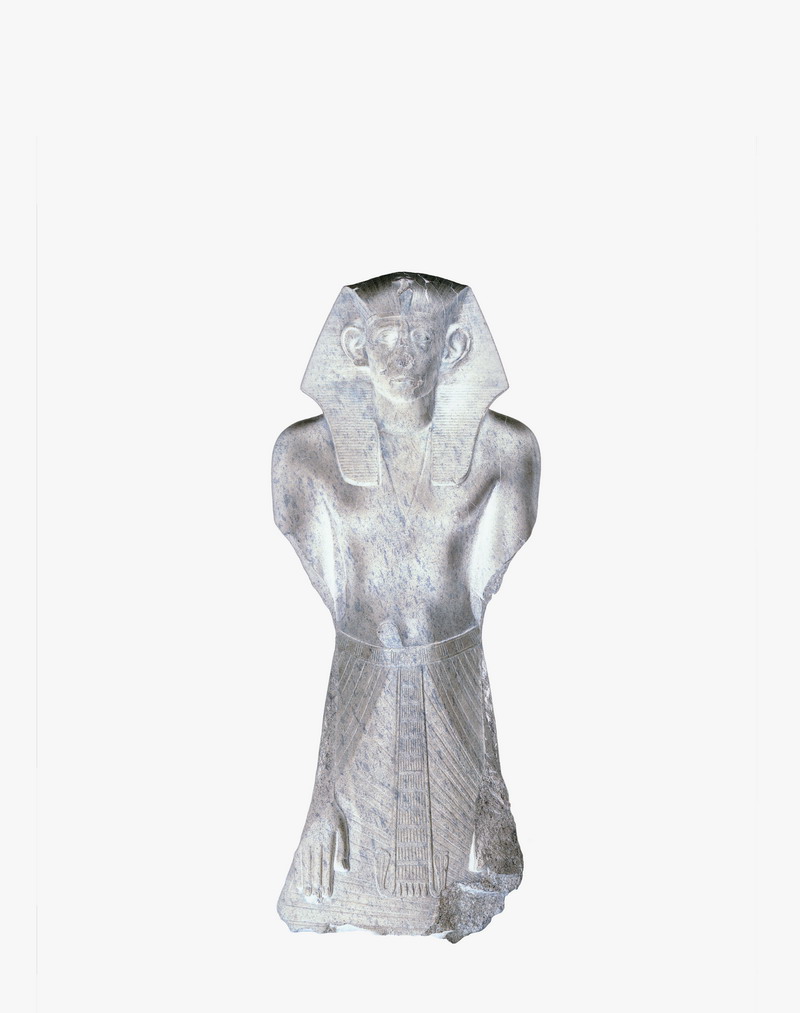 |
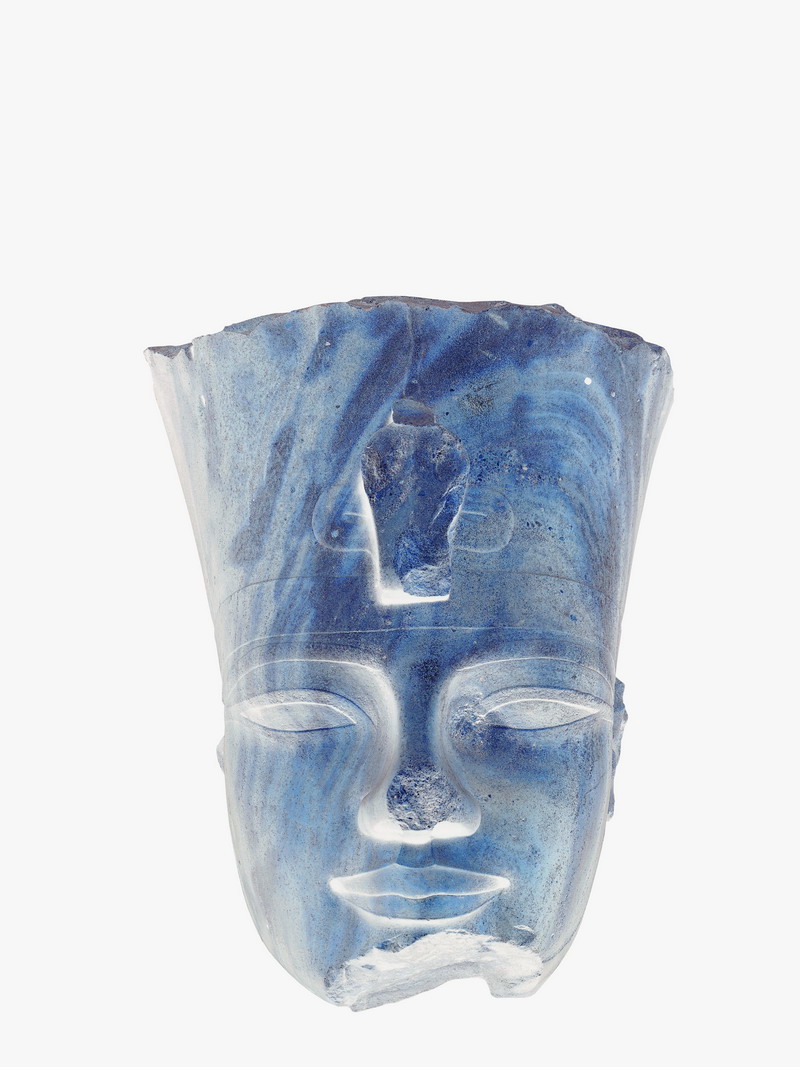 |
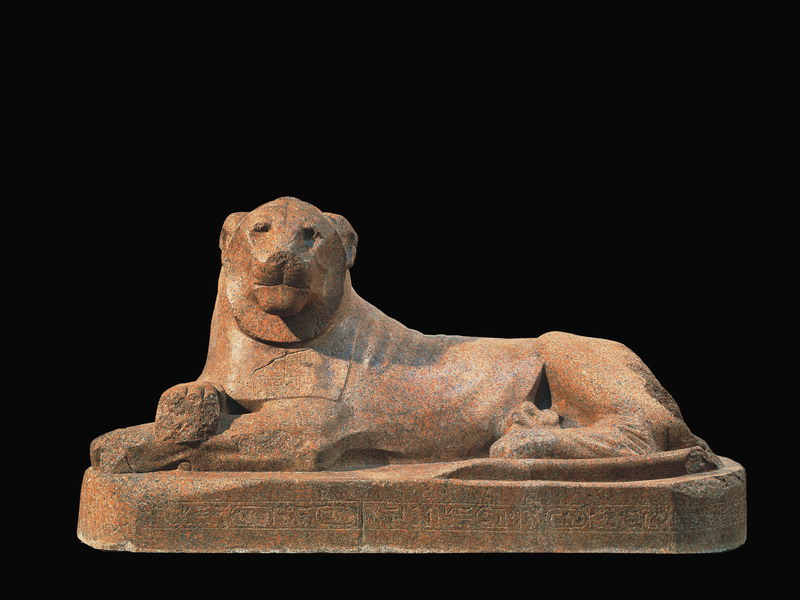 |
|
Standing Statue of Sesostris III
From Thebes, Deir el Bahri, funerary temple
of Mentuhotep II Middle Kingdom, Twelfth Dynasty, reign of Sesostris
III (ca. 1874-1855 BC) Granite Height 142.2 cm. (56 inches)
EA 686, gift of the Egypt Exploration Fund, 1905 © Trustees
of The British Museum, courtesy AFA
One of the most famous Egyptian statues
in The British Museum, this representation of Sesostris III
is the earliest depiction of a king in an attitude of prayer.
He wears a grave expression that may have had a symbolic meaning,
but his features are so individual that scholars must consider
the possibility
that they are close to how Sesostris actually looked.
|
Head of Amenhotep III
From Thebes, funerary temple of Amenhotep III
New Kingdom, Eighteenth Dynasty, reign of Amenhotep III (ca.
1390-1352 BC) Quartzite Height 133 cm (52 3/8 inches) EA 7,
acquired in 1835 at the sale of the Salt Collection © Trustees
of The British Museum, courtesy AFA
This colossal head comes from a massive
statue of King Amenhotep III that stood more than 8 metres
(26 feet) tall. The sculptor carved the eyes at a steep angle
so that they appear to look down at
observers from a great height.
|
Lion of Amenhotep III Reinscribed for Tutankhamun
From Gebel Barkal, originally from Soleb
New Kingdom, Eighteenth Dynasty, reign of Amenhotep III (ca.
1390-1352 BC)
Red granite 111 x 216 x 95.4 cm (43 3/4 x 85 1/8 x 37 5/8 inches)
EA 2, acquired in 1835, gift of Lord Prudhoe
© Trustees of The British Museum, courtesy AFAThis magnificent
lion once guarded a temple built by the great pharaoh, Amenhotep
III. The lion is one of a pair brought back and given to The
British Museum by British explorer.
|
The standing granite statue of Sesostris III , 56 inches tall, is
one of the most famous Egyptian statues in The British Museum's collection.
It shows the king in prayer with an unusually distinctive somber expression,
signifying that kingship was a heavy and difficult burden. Many such
sculptures in the exhibit have that 1,000-yard stare of those above
reproach.
The quartzite head of Amenhotep III was part of a colossal statue,
which stood more than 26 feet tall. It was one of a set commissioned
by this king who outdid all other kings in the size and number of
statues of himself. His large eyes seem to look directly through you,
wherever you move. He was worshipped as a god in his lifetime.
The magnificent red granite Lion of Amenhotep III, also one of a pair,
guarded a Nubian temple in 14th century B.C. Its larger-than-life
relaxed pose is exquisitely sculpted and weighs 5,000 pounds. Its
companion is also in The British Museum.
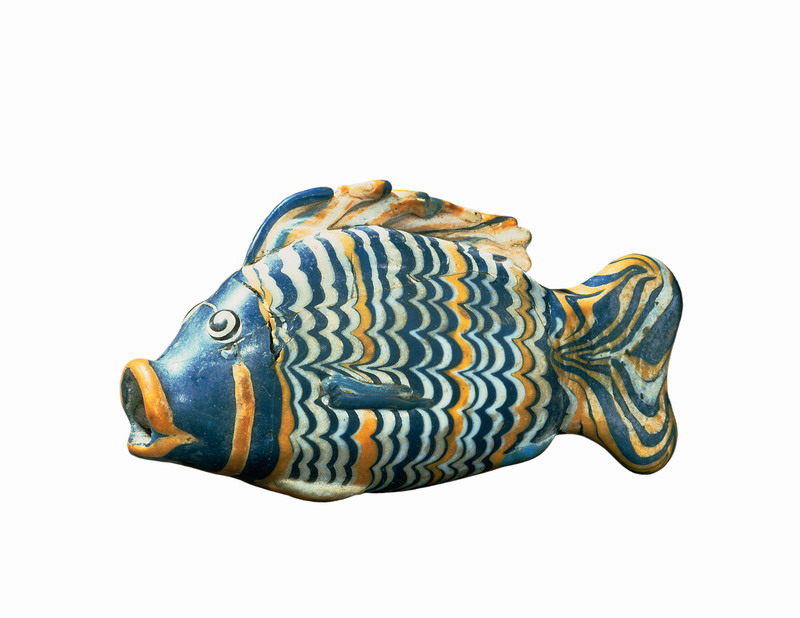 |
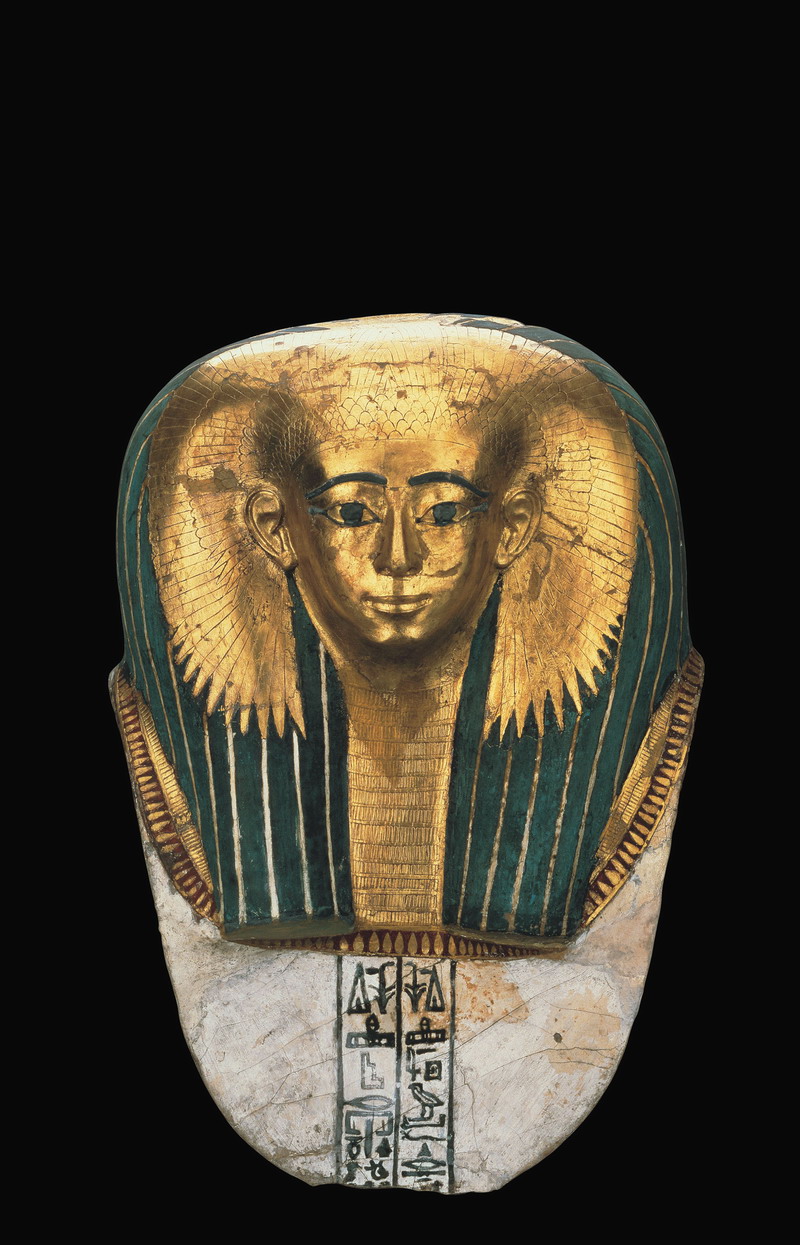 |
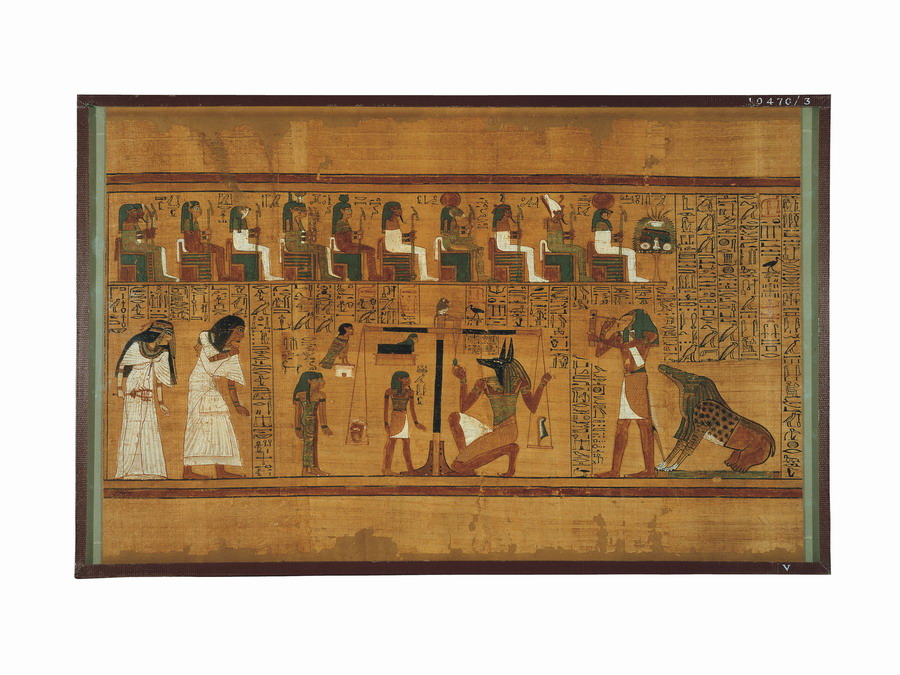 |
Bottle in the Form of a Bolti-fish
From Amarna, New Kingdom, Eighteenth Dynasty,
Reign of Amenhotep III or Akhenaten (ca. 1390-1336 BC) Polychrome
glass Length 14.5 cm (5 3/4 inches) EA 55193, gift of the Egypt
Exploration Society, 1921© Trustees of The British Museum,
courtesy AFA
This is the most spectacular and complete of
several surviving fish-shaped vessels.
The fish represented is a bolti, commonly found in shallow parts
of the Nile.
The female hatches and shelters her young in her mouth, making
the bolti a symbol of rebirth and regeneration.
|
Mummy Mask of Satdjehuty
Provenance Unknown
New Kingdom, early Eighteenth Dynasty (ca. 1500 BC)
Cartonnage, painted and gilded Height 33 cm (13 inches)
EA 29770, acquired in 1880, purchased at Morten & Sons from
the sale of the collection of Samuel Hull© Trustees of The
British Museum, courtesy AFA
The ancient Egyptians believed that the flesh
of their gods was golden. This splendid gilded mummy mask helped
its wearer, a high-ranking woman named Satdjehuty, merge with
the god Osiris in the Afterlife. In this way, she would become
a god herself, and live forever.
|
Book of the Dead, Papyrus of Ani:
Ani's Judgment
From Thebes, New Kingdom, Nineteenth Dynasty (ca.
1295-1186 BC)
Papyrus, Painted 42 x 66.3 cm (16 5/8 x 26 1/8 inches)
EA 10470/3, acquired in 1888, purchased via Sir E. A. W. Budge
© Trustees of The British Museum, courtesy AFA
This papyrus depicts the most dramatic scene
in the Book of the Dead. It is the moment when the
jackal-headed Anubis, guardian of the underworld, weighs the
heart of the deceased against a feather.
|
The glass perfume bottle in the form of a fish is the most spectacular
and complete of just a few surviving pieces. Just 6" long, its
bright colors come from turquoise, lapis lazuli and yellow jasper.
In ancient Egypt, the fish symbolized rebirth and regeneration.
The splendid golden Mummy Mask of Satdjehuty with a lapis lazuli-colored
wig covered the mummified face of a high-ranking woman. These paper-mache-like
masks were made of linen stiffened with plaster and placed over the
heads of mummies. This one is in near-perfect condition and stunning.
It is one of the exhibit's signature pieces, which appears on many
brochures and posters.
The Book of the Dead Papyrus of Ani's Judgement is one of the most
frequently published images from The British Museum's finest and best-preserved
Books of the Dead. It shows an ancient scribe being judged by the
jackal-headed god, Anubis. On the left is the heart, on the right,
a feather. If they balance, the dead man will safely enter the Afterworld.
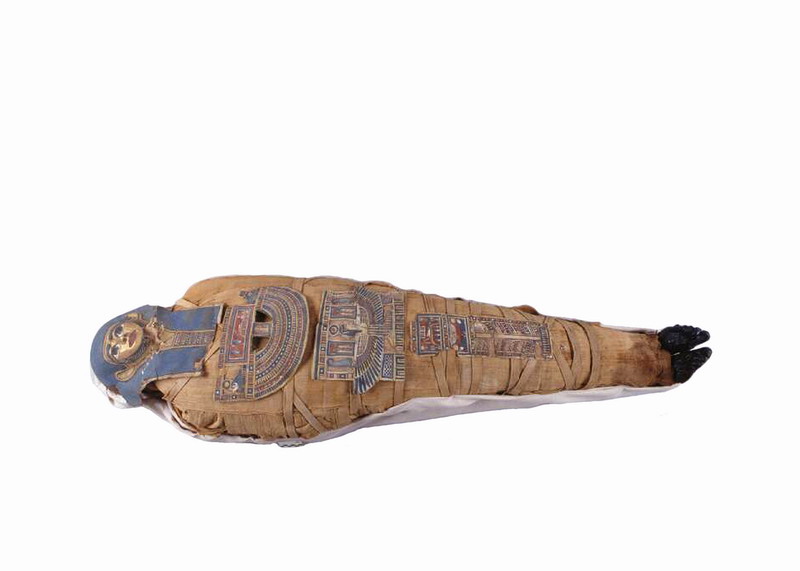 |
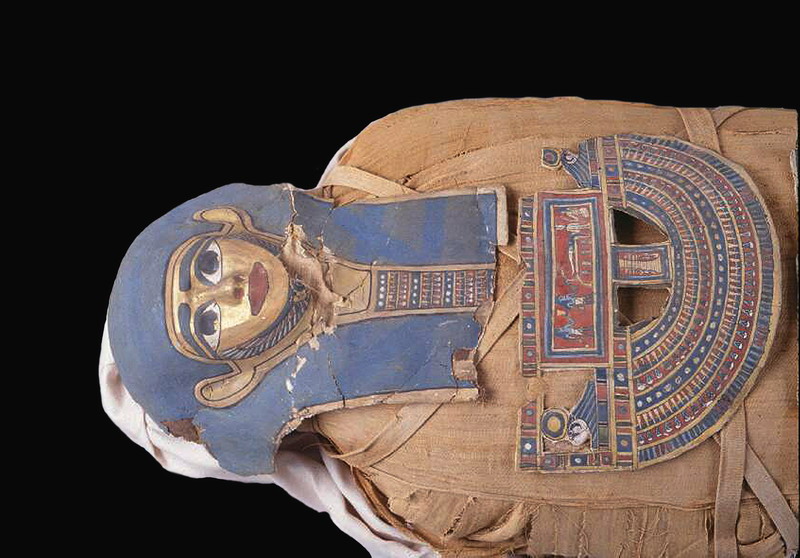 |
|
Mum's
the Word
|
No
Make-Up for 2,000 years!
|
Another staff addition and major bonus is positioned at the end of
the exhibit and just outside the Egyptian gift shop. It's the Mummy
Chamber, showcasing mummified humans and animals, and if you're visiting
with kids, don't miss this room! 2,000-year-old mummies of a brightly
decorated, footless woman and sarcophagus (photos Nellie 1&2)
(both on loan from Seattle's Burke Museum), a 10-year old boy (bought
in Luxor in 1915 as a souvenir) whose body is wrapped but his head
exposed and remarkably preserved, and four 3,000 year-old animals
(on loan from the Vancouver Museum) are fascinating adults and children
alike. A costumed member of the museum's interpretive staff presides
over a linen-wrapped corpse (constructed by the museum's staff - not
real, but looks darned human) and explains the rituals and science
of mummification. Also on view is a collection of tools and other
artifacts such as brain hooks, embalmer's knives and canopic jars
used in this mysterious aspect of the Egyptian culture so important
in their afterlives.
ADMISSION RATES (US, approximate) AND HOURS
Hours for The Royal BC Museum, July 10 through October 31: 10am-6:30pm
daily. Admission Rates: Adult, $17; senior (65+), youth (6-18) &
student (19+ with ID), $12; children (5 and under) free; family (2
adults, 2 youth under 19) $50. Admission rates for both the exhibit
and the National Geographic Imax Theatre showing "Mysteries of
Egypt:" Adult, $22; senior, youth and student, $17; children,
$4. Each paid admission includes an audio tour to Eternal Egypt and
access to any other part of the museum for that day. The exhibit operates
on reserved entry time so advance reservations are strongly recommended.
Royal BC Museum, (250)356-RBCM(7226), (250) 387-3701,1-888-447-7977,
www.royalbcmuseum.bc.ca Imax Theatre, (250)953-IMAX, www.imaxvictoria.com/main.html
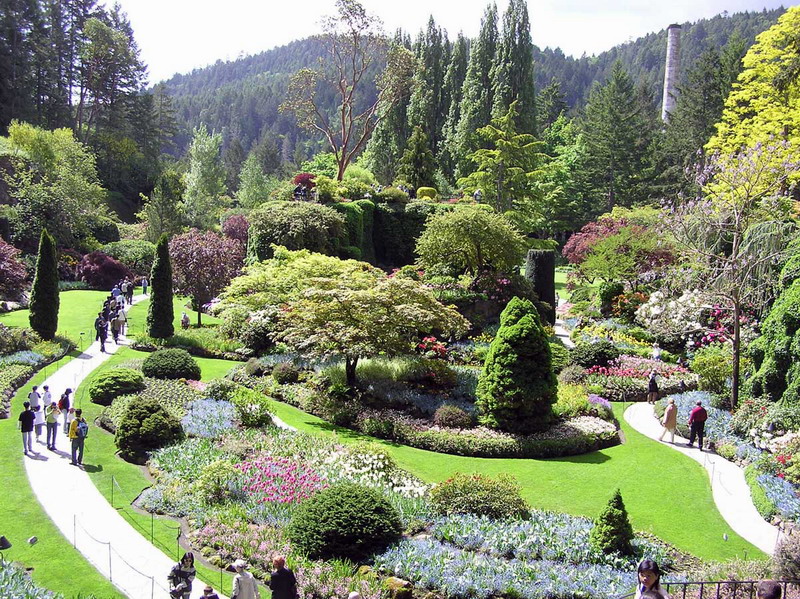 |
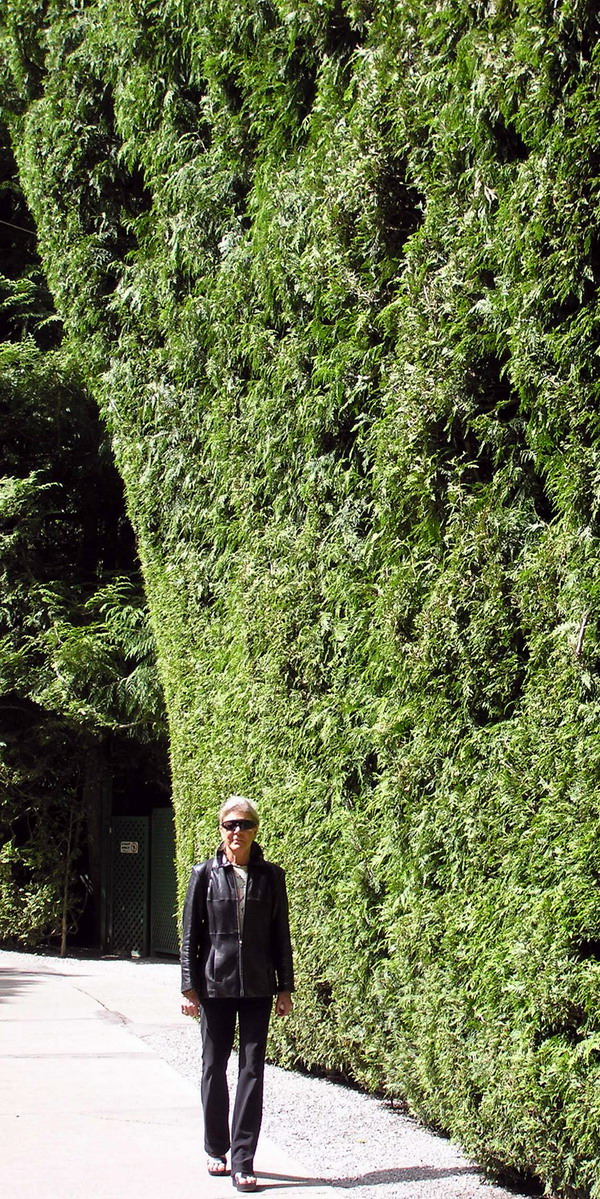 |
BUTCHART GARDENS CELEBRATES 100 YEARS
Hard to fathom, but The Butchart Gardens is celebrating 100 years
in bloom with a full roster of festivities throughout the summer
and into fall and winter. A new "Jennie Butchart" tulip
was unveiled in April, a bright lipstick red spiky, feathery flower,
developed especially for this centennial in honor of the woman
who made this happen. Whimsical topiary creatures have joined
the fray on the grounds and totem poles are being carved on site
to celebrate the close relationship The Gardens has with local
first nations tribes. |
|
Strolling
Thru Butchart
|
House-Sized
Butchart Hedge
|
|
Also hard to believe, these magnificent gardens evolved from an unsightly
limestone quarry, but only because of the due diligence and gardening
passion of the wife of the Vancouver Portland Cement Company's executive,
Jennie. Today, The Butchart Gardens has become a "must-see"
for all visitors to Vancouver Island, and rightly so. Every visit
to the Gardens in any season is spectacular.
Reserve some time for their restaurants - from elegant afternoon tea
and lunch and dinner menus to swell snacks - and for their huge gift
shop with endless surprises.
ADMISSION RATES (US approximate) AND HOURS
Hours for The Butchart Gardens now through September 30: 9am - 10:30
( through Sept. 5), -9pm (through Sept. 15), -5:30pm (through Sept.
30).
Admission rates: July through September 30, 2004: Adult, $16; youth
(13-17), $8; child 5-12), $1.50.
GETTING THERE
Butchart Gardens is located on the West Coast of Vancouver Island,
about 13 miles north of Victoria at 800 Benvenuto Ave., Box 4010,
Victoria, B.C. V8X 3X4, CA. If you're driving south from the Swartz
Bay Ferry Terminal, turn right off Hwy 17 onto McTavish Rd. Turn left
on West Sannich Rd., then right on Benvenuto Ave.
If you're driving north from Victoria, follow good directional signage,
turn left off Hwy 17 onto Keating X Rd. which leads into Benvenuto
Ave. and follow signs to the ticket booths and parking lots. If you're
without a car, convenient bus transportation is readily available
from Victoria. Call or visit the Gardens' website for current schedules
and more fascinating details. 1 250 652-5256, 1 866-652-4422; www.butchartgardens.com.
IF YOU GO
The museum and Tourism Victoria have partnered with hotels and restaurants
throughout the city to offer Mummy specials and Egyptomania. These
advantages include accommodation packages, restaurant menus with Egyptian
fare, a specially brewed Egyptian beer by Spinnaker Brewery and a
gaze at the Heavens of the Pharaohs at the Dominion Astrophysical
Observatory. To make reservations and for more information, visit
www.tourismvictoria.com
The Delta Ocean Pointe Resort and Spa (45 Songhees Rd., 1 250 360-2999,
www.deltahotels.com) with 239 rooms, a lovely spa, two great restaurants
and a lobby lounge complete with speaking parrot commands a majestic
view of the harbor from its north side. A paved path out front winds
along the waterfront. This is one of the many properties offering
a "mummy package" in partnership with the Eternal Egypt
exhibit.
Seaplanes leave from Seattle (45 minutes, $124 one way with an additional
$7 immigration fee, www.kenmoreair.com) or from Vancouver 35 minutes,
$75 one way, www.harbour-air.com).
Ground flights from Seattle and Vancouver also land at Victoria International
Airport.
A high-speed catamaran leaves from Seattle (2 ½ hrs., $70 one
way, foot passengers only, www.victoriaclipper.com).
Ferries leave from south of Vancouver (Tsawwassen, 90 minutes, about
$45 to $50 round trip for car, driver and one passenger, www.bcferries.com).
A foot ferry leaves from Bellingham's Cruise Terminal in Fairhaven
to Victoria's Inner Harbour every morning and returns every evening
($89 round trip, salmon/prime rib dinner optional on return for an
extra $10, www.whales.com). Secure parking is available at the terminal
for a nominal fee.
|